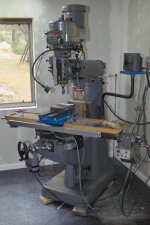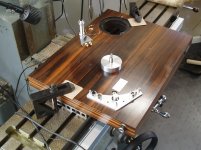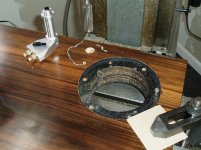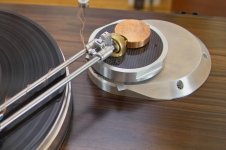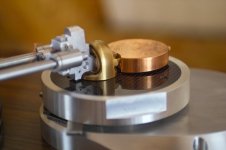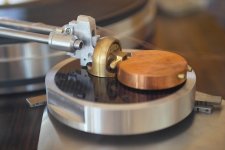No update since August, please don't keep us in suspense; does it work as a 'passive' device? or have you added a servo?
Hello ralphfcooke,
Hello to everyone who has been wondering,
I had to temporarily stop working on my Tone Arm because of financial reasons. It is not easy to support a project like this when you're retired on a fixed income. But I'll get it done "come Hell or high water"
I've since started to have doubts, that the friction drive will work properly. I think that it can be tuned to work with a particular record but may have to be retuned for the next record which may have a different composition of vinyl etc.
When I built the 2010 version of my Tone Arm, I allowed for the inclusion of a stepping motor, lead screw and associated components to drive the carriage. I actually already have the motor. It is made by Portescap and is 10mm in diameter.
During the time I could not do any physical work on my Tone Arm, I did plenty of work in my CAD program relating to the possible inclusion of a servo drive. Thinking and CAD work doesn't cost any money. You can do that all day long.
All the linear tracking Tone Arms I know, that use an electronic servo system, require that the Tone Arm pivots slightly out of true tangency in order to trigger the servo. Even though the error is so small that even a "golden ear" could not hear the resulting distortion, someone will say: "well, it's not perfect"
During my recent thinking period, I came up with a method to produce the electrical signal to trigger the servo without the Tone Arm loosing tangcy!
That change can be built into the existing prototype. Needless to say, I am extremely excited over that developement.
So, hopefully I'll have more to report soon.
Sincerely,
Ralf
Last edited:
I expect to go back to work on my Tone Arm starting Monday, November 21, 2011. I have temporaryly solved my financing problem. As I wrote earlier, I continued to work on my Arm in my CAD program and worked on future designs.
Sincerely,
Ralf
Hope you are having a good Christmas Holiday.
Andy news Ralf ?
Hi Ralf,
Looking forward to reading about and seeing all of the updates to your arm project!
Me too!!!!!
I'll write a description of the drastic changes I've made to my Tone Arm and post a few new pictures too.
Can't wait!!
RE: carbon fiber tubing ringing. Easton makes an aluminium tube with a carbon fibre jacket for use in archery arrows. Carbon fiber and epoxy resin bonded to 7075 core. Very stiff and straight, tolerances (reported by Easton) are .002" over 28" span. I have a few feet of this tubing to play with. It is 5/16" od with very thin walls and when tapped it sounds like it has a very high resonant frequency with very short decay, much better than the thicker walled larger diameter carbon only tubing I compared it to. Nothing measured, just by ear... FWIW.
Hello everyone,
I find it hard to believe that I haven’t posted since June 2012.
You may remember that the object of my tone arm was to utilize vinyl / stylus friction to pull the tone arm carriage along its tracks.
Sometime after June 2012 I got the tone arm to the point where it would play an LP. It has been pointed out by some readers of this thread, Frank Schroeder not being the least of them, that friction would not be constant across the LP and sure enough, the tone arm would not track at true tangency. There was a fraction of a degree of “lead or lag” depending upon modulation. The tracking error wasn’t much less than that of a pivoted tone arm.
Since my aim was perfect tangential tracking, I went back to the drawing board (CAD) and redesigned the tone arm until I found another solution. I kept the design of the carriage and the other mechanical features located in the base of the tone arm because it functioned quite well. I changed the design of the gimbals from a “C” shaped design to a closed cylindrical design which is much sturdier and easier to hold onto during machining. But now I have a dilemma: I made a design change to the tone arm that I have to keep to myself for the time being. Patent law is such, that if I make it public in this thread, I lose all rights to the invention. Hopefully I can resolve that problem later this year. The invention applies not only to my tone arm but to tone arms in general. I don’t want the big boys to take it away from me. I built two prototype tone arms since June 2012, one of which is mounted on my Micro Seiki turn table. As of now I have not found anyone to design the servo for me and I listen to music by manually nudging the tone arm carriage along its tracks with my thumb. Even though it is a fairly clumsy method, I am delighted to report that it doesn’t affect the quality of reproduction.
I have always treated my albums with great care and I can now enjoy the almost flawless playback through my modest system. I can only sit down and listen for about 30 seconds before I have to get up and correct the carriage position but I’ll solve the servo problem sometime this year. In the meantime it’s good exercise.
Here are some pictures:
1) My Bridgeport milling machine with which I made most of the parts.
2) My Micro Seiki turn table being machined to accept the tone arm’s DIN connector.
3) A close-up of the above. Note the lead chip from the layer of sheet lead in the base.
4) The tone arm overall. (minus head shell)
5) The tone arm base and carriage.
6) As above.
Since the pictures were taken, I properly located the tone arm wires inside the left tone arm tube.
I’ll post more pictures soon.
Sincerely,
Ralf
I find it hard to believe that I haven’t posted since June 2012.
You may remember that the object of my tone arm was to utilize vinyl / stylus friction to pull the tone arm carriage along its tracks.
Sometime after June 2012 I got the tone arm to the point where it would play an LP. It has been pointed out by some readers of this thread, Frank Schroeder not being the least of them, that friction would not be constant across the LP and sure enough, the tone arm would not track at true tangency. There was a fraction of a degree of “lead or lag” depending upon modulation. The tracking error wasn’t much less than that of a pivoted tone arm.
Since my aim was perfect tangential tracking, I went back to the drawing board (CAD) and redesigned the tone arm until I found another solution. I kept the design of the carriage and the other mechanical features located in the base of the tone arm because it functioned quite well. I changed the design of the gimbals from a “C” shaped design to a closed cylindrical design which is much sturdier and easier to hold onto during machining. But now I have a dilemma: I made a design change to the tone arm that I have to keep to myself for the time being. Patent law is such, that if I make it public in this thread, I lose all rights to the invention. Hopefully I can resolve that problem later this year. The invention applies not only to my tone arm but to tone arms in general. I don’t want the big boys to take it away from me. I built two prototype tone arms since June 2012, one of which is mounted on my Micro Seiki turn table. As of now I have not found anyone to design the servo for me and I listen to music by manually nudging the tone arm carriage along its tracks with my thumb. Even though it is a fairly clumsy method, I am delighted to report that it doesn’t affect the quality of reproduction.
I have always treated my albums with great care and I can now enjoy the almost flawless playback through my modest system. I can only sit down and listen for about 30 seconds before I have to get up and correct the carriage position but I’ll solve the servo problem sometime this year. In the meantime it’s good exercise.
Here are some pictures:
1) My Bridgeport milling machine with which I made most of the parts.
2) My Micro Seiki turn table being machined to accept the tone arm’s DIN connector.
3) A close-up of the above. Note the lead chip from the layer of sheet lead in the base.
4) The tone arm overall. (minus head shell)
5) The tone arm base and carriage.
6) As above.
Since the pictures were taken, I properly located the tone arm wires inside the left tone arm tube.
I’ll post more pictures soon.
Sincerely,
Ralf
Attachments
Hello RCruz,
Thank you for your comments.
I need a microcontroller based electromechanical servo.
I am attaching a block diagram of the planned servo.
The microcontroller should provide the various stepping motor frequencies needed for tracking the groove and for traversing the tonearm accross the LP. I have a list of the frequencies needed.
I know enough about electronics to know what I need but not enough to design the circuit myself. I know how to prototype it and build it once I have a circuit diagram.
It is my intention to custom make the tonearm or interest a manufacturer in marketing it.
Sincerely,
Ralf
Thank you for your comments.
I need a microcontroller based electromechanical servo.
I am attaching a block diagram of the planned servo.
The microcontroller should provide the various stepping motor frequencies needed for tracking the groove and for traversing the tonearm accross the LP. I have a list of the frequencies needed.
I know enough about electronics to know what I need but not enough to design the circuit myself. I know how to prototype it and build it once I have a circuit diagram.
It is my intention to custom make the tonearm or interest a manufacturer in marketing it.
Sincerely,
Ralf
Attachments
Last edited:
- Status
- This old topic is closed. If you want to reopen this topic, contact a moderator using the "Report Post" button.
- Home
- Source & Line
- Analogue Source
- My 1980's Tangential Tone Arm and my 2010 improvement
